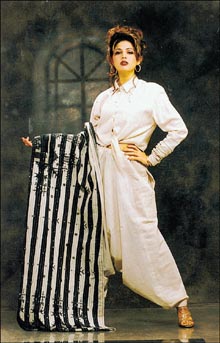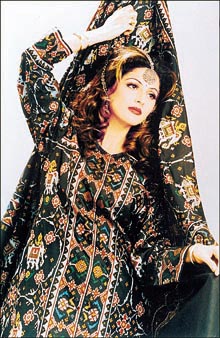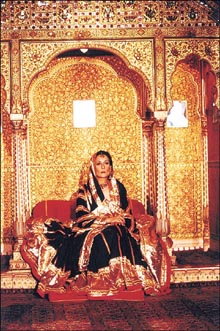Fashion
20th
Century’s sunshine sector
In the
20th century Indian fashions have swung from the
traditional to the western and now seem to be going back
to their roots with leading designers re-elevating the
textile craftsman to the lofty status he enjoyed in the
pre-British era, says Manisha Diveshwar.
AN old man peered through his
spectacles at the charkha he was spinning. Clad
only in a loin-cloth, he spun, thread by thread, inch by
inch, what was to become India’s most eloquent
symbol of freedom.
 The khadi that Gandhiji wove became
a unique and effective form of protest, a gift that
helped rediscover the rich textile heritage and the
diversity and depth in the weaves and crafts of India. The khadi that Gandhiji wove became
a unique and effective form of protest, a gift that
helped rediscover the rich textile heritage and the
diversity and depth in the weaves and crafts of India.
It was a process of
re-discovery. Over the years, the British worked on a
plan of altering India’s textile trade and changed
its role from the largest supplier of textiles to the
world to the largest importer of English cloth. Writes
leading designer Ritu Kumar in her book, Costumes and
Textiles of Royal India," A century of colonial
rule rang a death knell to traditionally produced Indian
fabrics which almost went extinct."
Gandhiji’s master
stroke of elevating the charkha to a national
stature was not just a symbolic protest but also
showcased the rich textile heritage of India which, over
the years, had been systematically plagiarised by the
British who began replacing the skills of Indian
handicraft workers with cheap imitations made in the
mills of Birmingham.
The charkha
changed all that and once again the Indian textiles
started to get revived. So much so, 50 years on, today,
India is now being considered a storehouse of designs by
leading couturiers of the world. No other country has on
offer the variety of fabrics, weaves and crafts as India.
It is not surprising that these are being sought after by
designers in the world’s fashion capitals like
Paris, London and New York.
The Indian fashion scene
has evolved at breakneck speed in the last decade of this
century. Though very much a part of the lifestyles at the
turn of the century, during the Raj days fashion used to
be the exclusive domain of the aristocracy.
The complete adoption of
Western dress occurred only in the beginning of the 20th
century when the Indian royalty changed its attire. Ritu
Kumar writes, "The British idea of civilised dress
codes caused a crisis of identity which unfortunately
shifted India’s royal family’s preference for
foreign fabrics, and patronage to its weavers was
withdrawn."
The
colonial influence
By the beginning of the
20th century, maharajas and nawabs had begun to
incorporate European styles in their poshaks. For
example, at state functions, they wore British coronation
robes duly decorated with stars and medals held together
with cords and jewelled broaches  on
their traditional clothing. Interestingly, the turban,
topee and jootie still remained. on
their traditional clothing. Interestingly, the turban,
topee and jootie still remained.
The zenana,
however, continued to be in purdah. Her zardozi
ghaghras and duputtas handworked with beads
and jewels, duly complemented the heavy brocade and gota
on sarees with intricately designed jewellery.
By the 1920s, the
younger princes were beginning to adopt completely
western wear, having given up their sherwanis, achkans
angarkahas and jamas. The queens and
princesses maintained their traditional attire for the
simple fact that their husbands were interacting socially
with the British and their colourful, heavy ghaghras
were a perfect foil for the lighter, western-style
dresses the men wore.
In the late 1930s when
women started to break loose from the traditional
clothes, in came the formal saree. The fashion statement
was again made by the then queens and princesses led by
Maharani Gayatri Devi of Jaipur whose chiffon sarees,
with or without borders and delicate jewellery, became a
craze with women.
Comical
ensemble
With passing years, the babus
too had a change of mindset about clothes. Out went
the kurta and in came the stiff white cotton shirt
with cuffs worn over a dhoti, a dark coat, white
socks, shoes and an umbrella. This completed what Ritu
Kumar calls a "Comical ensemble".
The result of this
predilection for western wear was that traditional
techniques of patterning, spinning and weaving by master
craftsmen began dying. To an extent these masters had
also themselves to blame as they jealously guarded the
secrets of their craft and never taught them to
outsiders.
The result was that the
cheap initiations from Britain virtually snuffed out
exclusive Indian craftsmanship in textiles. The
traditional designs of Srinagar, Varanasi, Surat
Murshidabad and Ahmedabad began to get mass produced in
England. Even the stunning Kashmiri shawls were imitated
in Edinburgh and Norwich with the help of modern machines
and the original lost out to competition by the
mid-twentieth century.
Ritu Kumar says,
"Two arts that died are the textiles of Kashmir
woven in the kanni weave more popularly known as
the jaamawar shawl and the ultra-fine cotton
muslin of Bengal. However, they were lost but fortunately
they didn’t die."
It was in protest
against such British practices that khadi became the
symbol of Independence in 1920 and all imported fabric
began to be burned. Khadi kurta over khadi dhoti
or pyjamas or and Gandhi cap for men and khadi
sarees for women became the dress code of all Indians
during those turbulent times. With such an emphasis on
Indian fabric, the vast legacy of textile craft was
revived within two decades of India’s Independence.
The revival of
India’s traditional textile arts and techniques was
pioneered by Kamaladevi Chattopadhyay. Looking for ways
to embellish her khadi sarees, she broke the cast
taboo and went about organising weavers and craftsmen.
Ritu Kumar revived the Zardozi, Pranavi Kapur the
muslin khadi and Calcutta designers Mona-Pali the kantha
work and its motifs on sarees.
Experiments
with the saree
Views on how the saree
evolved differ. Ritu Kumar says a new dimension was given
to the saree by Rabindranath Tagore’s sister in-law
Yanodanandini in 1870 by wearing it over a petticoat with
a blouse to match. Lina Luyton, in her book Sarees of
India, says the saree can be traced back to the
Brahmo Samaj days.
 Whatever the exact date, the fact is that
the saree started enjoying a cosmopolitan acceptance
across different regions as British dresses were
restrictive and unsuited to Indian conditions. Whatever the exact date, the fact is that
the saree started enjoying a cosmopolitan acceptance
across different regions as British dresses were
restrictive and unsuited to Indian conditions.
From the early part of
the 20th century, women’s experiments and
innovations only went so far as increasing or shortening
the length of the pallav, or wearing it elegantly over
their heads or, with the passage of time, just
nonchalantly throwing it over the left shoulder.
Vandana Bhandari,
assistant professor, at National Institute of Foreign
Technology (NIFT) says, "Unlike the saree, the
blouses began to be experimented with. When women in the
West wore highnecks, fluffs and flounces, Indian
women’s blouses had lace fluffs on the neck and the
sleeves. Necks went higher or lower according to the
western fashion. Long sleeves or short ones, frills and
sleeve edges were dictated by the West."
After Independence, the
erstwhile kings and princes lost their British patronage
and they in turn withdrew their patronage to the karigars
who began languishing in poverty. Several
attire-related arts which thrived earlier were in danger
of getting lost. This, coupled with the fact that most of
India’s crafts and weaves were highly
time-consuming, made the end product out of reach of the
common man.
According to Ruby
Kashyam, convener, Publica-tion Department of NIFT, some
of the few such near-casualties were the Patan Patoles
from Gujarat, the ikat from Orissa and Andhra,
the Baluchars and Jamdanis from Bengal, the
Paithani from Maharashtra and the brocades from
Benaras.
Post-Independence
generation
After Independence,
women who had taken part in the freedom movement entered
politics and the first signs of social change began
appearing on the horizon. They became more confident in
their roles outside the confines of the kitchen and
gradually started looking for more practical and
convenient garments.
 This
paved the way for the Punjabi salwaar-kurta. It
was a convenient and comfortable wear, well within the
confines of modesty and feminine grace and yet it made a
unique fashion statement. This
paved the way for the Punjabi salwaar-kurta. It
was a convenient and comfortable wear, well within the
confines of modesty and feminine grace and yet it made a
unique fashion statement.
According to Vandana
Bhandari, the arts of stitching and embroidering have
been known to Indians since pre-historic times, but we
always preferred unstitched garments as they were
considered pure.
That’s why along
with modern attire, women retained the unstitched
garments like the Odhni or the chunari as
an integral part of their couture wear, Vandana Bhandari
adds.
"In the sixties and
seventies, the printed nylon and chiffon sarees which
were crease-free and easy to maintain became the
in-thing."
These two decades also
saw the invasion of the hippy movement. Partying and
dancing was introduced to the Indian culture and replaced
devotional gatherings and classical dances. With parties
came a sudden change in attire.
Designer Pranavi Kapur
says, "The sarong was adopted for party wear.
But contrary to popular impression that it originated in
the Orient, the sarong has traditionally been a
part of the heavy garment worn by Punjabi, Keralite and
Maharashtrian women during weddings and festive
occasions.
Role
of cinema in fashions
Interestingly from
1950s, cinema started playing a big role in the lives of
the younger generation and whatever the popular stars
wore became fashion.
Indian cinema, in turn,
was influenced by Hollywood which brought in the minis
and consequently, the length of the kameez was
shortened.
 For long, cinema had portrayed that only
the vamp wore tight trousers and low-necked tops with
exposed mid-riffs. The good women dressed only in sarees
or salwaar-kurtas. For long, cinema had portrayed that only
the vamp wore tight trousers and low-necked tops with
exposed mid-riffs. The good women dressed only in sarees
or salwaar-kurtas.
But soon all that
changed as modern heroines began wearing western outfits.
"Asha Parekh’s skin-tight kurtas and
Mumtaz’s mini shirts, were copied on Indian roads as
well," says Ruby Kashyam.
However, these tights
were short-lived as they were impractical for Indian
women who were traditionally used to loose and
comfortable clothes. Along with the kurta becoming
looser, the sleeves too underwent changes — from
skin tight to bell-shaped to puffs and even sleeveless.
The size of salwaar ponchas changed with every
passing season. There were basically three salwaar styles
— Patiala, Dogri and the Pathani.
In the ’80s, the dhoti
salwaars and churidars came into vogue.
Prolific use of net, lace, frilled collars, ruffled
sleeves for tops came in as well. But it was still the
decade of the saree for women and staid suits for men.
The dawn of the nineties
changed all that. Communication explosion and the
corresponding rise in the economic status of urban
families turned the fashion scene on its head. Thanks to
the Miss India, Miss Universe, Miss World and other
international pageants, Indian fashions began to get
appreciated worldwide.
With new and innovative
designers graduating from prestigious schools like the
National Institute of Fashion Technology, the scene has
undergone a complete metamorphosis. In fact the wheel has
come full circle in the century. Indian fashions have
swung from the traditional to the western and now seem to
be going back to their roots, the Indian craftsmen have
been re-elevated to their lofty status by leading
designers of the country.
In the coming
millennium, Kumar says, we will be celebrating the legacy
left to us, of the world’s richest repertoire of
handicrafted textiles. In her book she writes that what
is remarkable is that Indian traditional textiles do not
"exist in the rarefied atmosphere of a museum
workshop in an artist’s atelier.... they survive in
the vast weaving, printing, embroidery and dyeing belts
of the country..."
For once, at the turn of
the century, Indian women and men have the freedom to
experiment with whatever is beautiful and affordable.
—
Newsmen Features
|

